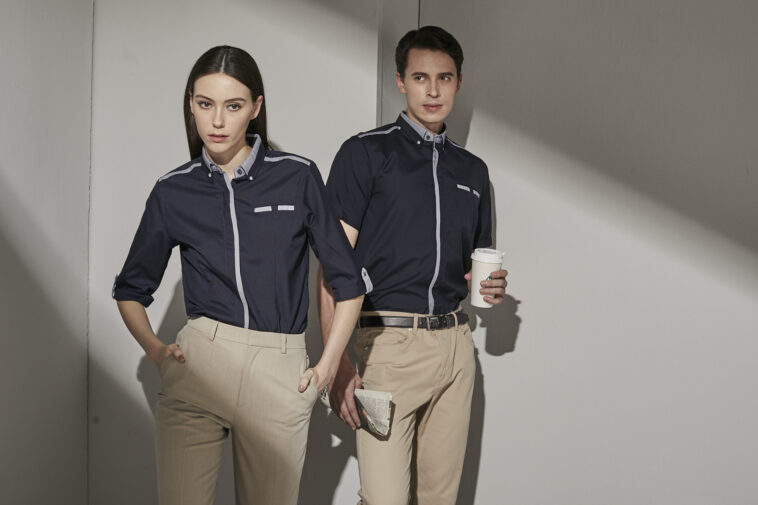A professional first impression starts with uniforms designed for perfection. Whether you’re outfitting employees, sports teams, or creating something for a special event, custom made uniforms are an excellent way to ensure your team stands out and looks unified.
What approach should you use to develop an ideal customized work attire? Anyone interested in beginning their custom uniform design project should follow this comprehensive guide.
Plus, we’ll explore how to choose a reputable company uniform supplier that can bring your vision to life.
Why Choose Custom Made Uniforms?
Custom made uniforms offer many benefits. Custom uniforms combine both aesthetic value with a unifying power and provide motivational benefits to employee teams. The act of dressing in custom-made corporate uniforms produces a feeling of organizational membership among staff members. A thoughtfully designed custom uniform stands as a branding instrument which strengthens recognition of your company’s principles and core values and mission and company identity.
However, creating the right custom made uniforms isn’t as simple as picking out a color and slapping a logo on it. Your uniform design requires a thorough evaluation of fabric benefits for usability alongside wearability along with longevity. Aside from functional attributes the design strategy must demonstrate the established character of both the company and its crew members. To achieve the best custom uniforms for your team apply these steps for design development.
Step 1: Identify the Purpose and Audience
Before diving into colors, fabrics, and designs, it’s crucial to consider the primary purpose of the custom made uniforms. Which context would your uniforms serve? Between corporate offices and restaurants together with sports organizations and industrial facilities. Your business type along with event purpose drives the selection of core design elements. For example:
-
Uniform clothing for employee use should integrate both workplace professionalism requirements with clothing comfort needs.
-
Sports team uniforms must combine capability to stand up to wear and tear with the need to move freely.
-
A restaurant uniform combines maintenance flexibility as a priority with aesthetic design goals.
Setting the groundwork for all design decisions requires determining both your audience and the intended role of the uniform. Design your uniforms to show what your company represents because this opportunity serves to build stronger brand recognition with others.
Step 2: Choose the Right Fabric
Fabric choice is a pivotal element when designing custom made uniforms. For optimal performance the material selection requires alignment to uniform function and needs to ensure both durability and comfortability. Some fabric options include:
-
Cotton: Cotton remains the favorite material for office uniforms alongside casual work attire because of its smooth yet breathable nature.
-
Polyester: Due to its moisture-wicking capabilities and lightweight nature and durable characteristics polyester finds common use in sports uniform fabrication.
-
Blends: Twin materials that mix cotton together with manufactured fabrics offer substantial comfort plus long-lasting use for day-to-day activities.
-
Tactical Fabrics: The construction industry among others requires heavy-duty uniforms so tactical fabrics are selected because they deliver wear-protection alongside durability.
Your choice matters when selecting fabric since the material must have the capability for machine washing or it will need specific care instructions. Discuss your needs with a company uniform supplier to find the best options available for your uniform design.
Step 3: Pick the Right Colors and Design Elements
Your chosen colors determine how your uniform defines itself. Choose colors that properly represent your business values as well as your team’s image. Here are a few tips on color selection:
-
Brand Colors: When you design business uniforms implementation of your brand colors creates consistency which Strengthen brand perception.
-
Contrasting Colors: On the field the contrasting colors between jerseys and shorts enable players to become easier to differentiate.
-
Practicality: Lighter uniform colors usually fail to meet practical needs in professional environments that experience heavy soiling. A darker color scheme or color blocking combination works better instead.
The design process needs to feature elements that differentiate your clothing from others. A combination of logos together with text elements and specific graphics helps build a powerful visual presence. If you’re unsure where to start, work closely with a company uniform supplier to incorporate elements like:
-
Embroidered logos
-
Slogans or taglines
-
Customized patterns or designs
Remember, simplicity is key. Select designs with right mix of personality and clarity because too many elements create disorganized and unprofessional looks.
Step 4: Ensure Comfort and Fit
Comfort should be one of your top priorities when designing custom made uniforms. The uniforms your employees wear for extended periods need to deliver comfort together with functionality along with appearance quality.
Consider the following factors when designing the fit:
-
Sizing: Provide an array of sized uniform options to reach every body type so employees will feel joy in their uniforms.
-
Cut and Shape: Your choice of fit will depend on the activity since a tight silhouette works better for professional situations but loose-cut styles work better for sports activities.
-
Flexibility: Design options with versatility for freedom of movement will be your guiding principle because active uniforms require this flexibility.
-
Layering Options: When dealing with cold outdoor conditions you should provide jackets or sweaters together with the primary official wear.
Collaborating with a company uniform supplier that provides tailored fitting options or adjustable designs will give you the flexibility you need for all body types and roles.
Step 5: Work with a Reliable Company Uniform Supplier
Once you have a design concept in mind, it’s time to partner with a company uniform supplier who can bring your ideas to life. Choose a supplier who offers:
-
High-Quality Materials: Choose a supplier specializing in superior materials that produce both comfortable and enduring materials for your uniforms.
-
Customization Options: Your supplier should provide extensive customization options which include screening and embroidering your chosen design elements.
-
Timely Delivery: You need to work with a supplier who guarantees your uniform delivery on time so you won’t experience delays in getting your order.
Good Customer Service: Suppliers who are willing to help refine design choices while sharing expertise about materials turn out to be enormously beneficial according to first-time custom uniform designers.
Conclusion
Designing your own custom made uniforms is an exciting opportunity to create something that represents your team or business while maintaining functionality and comfort. Create uniforms with your team’s involvement because your business can achieve an amazing uniform showing everyone’s pride.
This post was created with our nice and easy submission form. Create your post!





